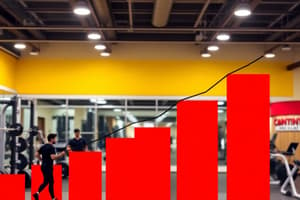Podcast
Questions and Answers
What characteristic of the typical American assembly line worker by 1950 is highlighted in the content?
What characteristic of the typical American assembly line worker by 1950 is highlighted in the content?
- He had less medical care than previous generations.
- He experienced limited means of transportation.
- He relied on community support for entertainment.
- He enjoyed similar comforts to that of a medieval king. (correct)
What is described as one of the miracles an American worker could experience in the 20th century?
What is described as one of the miracles an American worker could experience in the 20th century?
- Working exclusively as a business owner.
- Talking with friends over long distances. (correct)
- Riding a horse-drawn carriage.
- Living without any form of medical care.
What does the author refer to the new employee model as?
What does the author refer to the new employee model as?
- The entrepreneurial employee model.
- The traditional employee model.
- The prosperous employee model. (correct)
- The declining employee model.
How long did the prosperous employee model reportedly last?
How long did the prosperous employee model reportedly last?
What disadvantage did many individuals face by 1980 regarding the prosperous employee model?
What disadvantage did many individuals face by 1980 regarding the prosperous employee model?
What important change occurred after 1970 regarding employment models?
What important change occurred after 1970 regarding employment models?
What general misconception do many people have about the prosperous employee model?
What general misconception do many people have about the prosperous employee model?
What is one of the two original models for achieving success as mentioned?
What is one of the two original models for achieving success as mentioned?
Why was working for a ruler considered a more secure income?
Why was working for a ruler considered a more secure income?
What role does an entrepreneur play in a business?
What role does an entrepreneur play in a business?
What was the primary business before the Industrial Revolution?
What was the primary business before the Industrial Revolution?
What financial risk does a business owner take compared to an employee?
What financial risk does a business owner take compared to an employee?
What was a consequence of the small size of government in America until the 20th century?
What was a consequence of the small size of government in America until the 20th century?
How did the Industrial Revolution impact employee wages by the 20th century?
How did the Industrial Revolution impact employee wages by the 20th century?
Why do business owners typically work longer hours than employees?
Why do business owners typically work longer hours than employees?
Flashcards
Capitalizing the business
Capitalizing the business
The practice of using personal savings to start or buy a business.
Entrepreneur
Entrepreneur
A person who starts, owns, and runs a business.
Working for the ruler
Working for the ruler
The historical model where people worked for rulers, gaining income and security based on position.
Owning a business
Owning a business
Signup and view all the flashcards
Pre-industrial business model
Pre-industrial business model
Signup and view all the flashcards
Impact of the Industrial Revolution
Impact of the Industrial Revolution
Signup and view all the flashcards
American work model (pre-20th century)
American work model (pre-20th century)
Signup and view all the flashcards
Why business owners earn more
Why business owners earn more
Signup and view all the flashcards
Prosperous Employee Model
Prosperous Employee Model
Signup and view all the flashcards
Shift from Business Owner to Employee Model
Shift from Business Owner to Employee Model
Signup and view all the flashcards
Decline of Prosperous Employee Model
Decline of Prosperous Employee Model
Signup and view all the flashcards
Steady Career Progression
Steady Career Progression
Signup and view all the flashcards
Limited Career Opportunities and Financial Stability
Limited Career Opportunities and Financial Stability
Signup and view all the flashcards
Improved Material Quality of Life
Improved Material Quality of Life
Signup and view all the flashcards
Employment as a Path to Prosperity
Employment as a Path to Prosperity
Signup and view all the flashcards
Study Notes
Models for Success Throughout History
- Two primary models for achieving success have existed: working for a ruler/government or owning a business.
Early Models (Pre-Industrial Revolution)
- Working for a ruler: Provided a more secure income due to the government's taxing power. Financial security increased based on the level of government position.
- Owning a business (primarily farms): This involved saving to start or buy a business. The entrepreneur, the business owner, typically earned more than employees during good times and was less likely to lose their job in bad times.
Business Ownership Advantages
- Profitability: Business owners earned more than employees when successful.
- Job Security: Owners were often the last to lose their jobs during economic downturns.
- Risk: Owning and running a business involved financial risk of losing assets.
- Effort: Owners typically worked longer hours, especially during the business's early stages.
American Context (Pre-20th Century)
- Business ownership dominant: Owning a business was the most common route to financial security. Government employment was limited.
- Limited employment: Individuals faced a limited choice: own a business or be an employee.
The 20th Century – The Rise of the Employee Model
- Increased employee wages: Industrial Revolution made businesses extremely productive, allowing employees to earn higher wages and improved living standards.
- Significant improvement in living standards: 1950s employees had better quality of life compared to previous generations, including improved healthcare, food, transportation, and entertainment.
- Employee model emerges: The employee model became a viable and highly successful pathway for financial prosperity.
The 20th-Century Employee Model (Prosperous Employee Model)
- Duration: Roughly 1900-1970.
- Assumption of permanence: Modern Americans assumed this model was always common despite its relative newness.
- Assumption's lack of knowledge: Few understood the historical context, making the model seem established and permanent.
Decline of the 20th-Century Employee Model
- Difficulty in success: By the 1980s, the prospect of a reliable wage increase through an established company had significantly decreased.
- Challenges for many: Millions of people who followed this model faced stagnation or even decline in their financial situation.
Studying That Suits You
Use AI to generate personalized quizzes and flashcards to suit your learning preferences.




